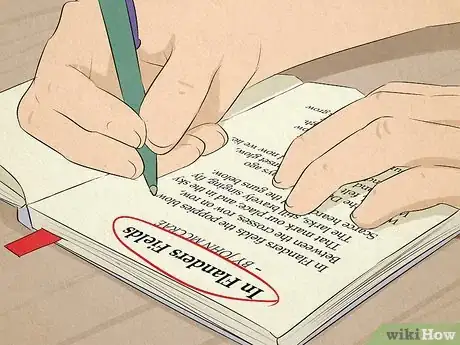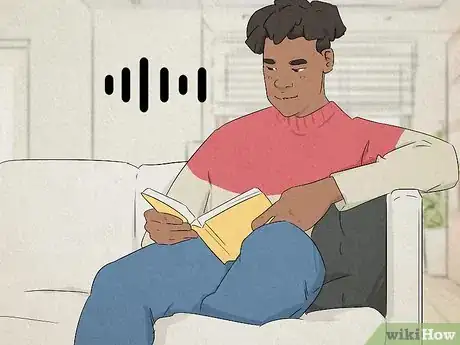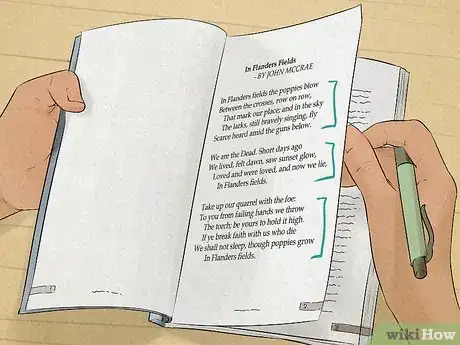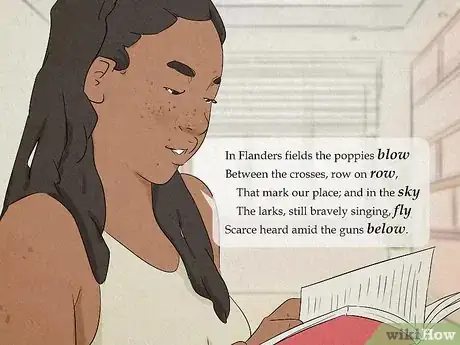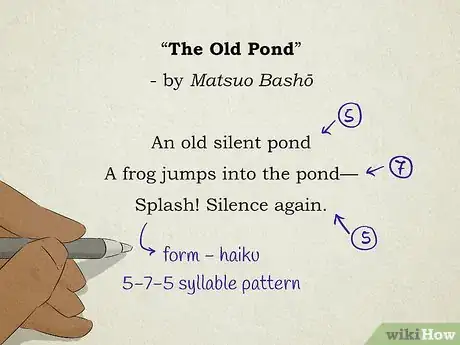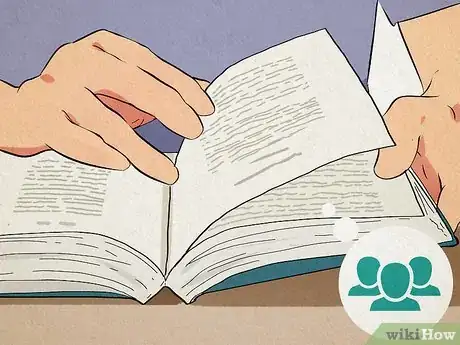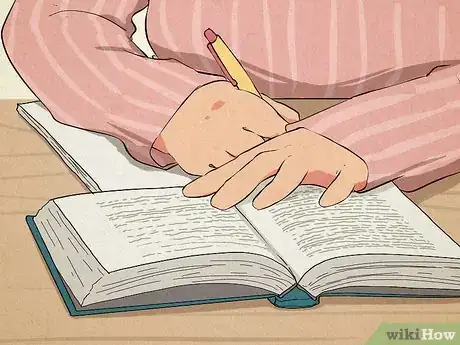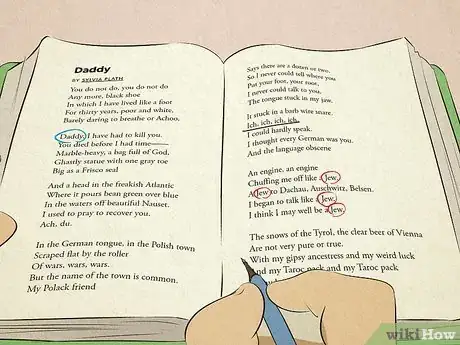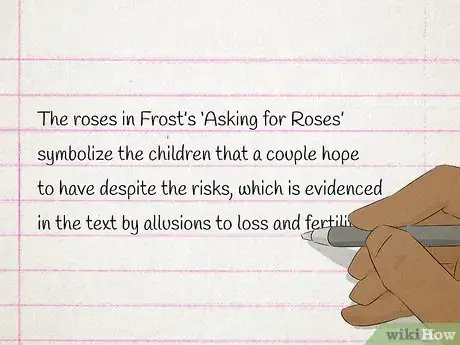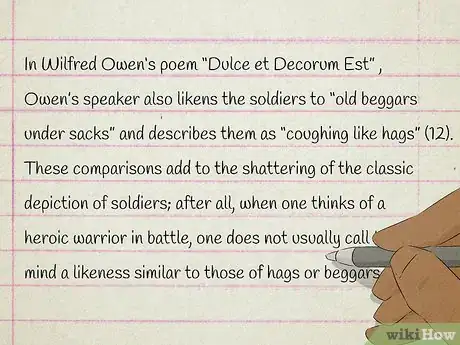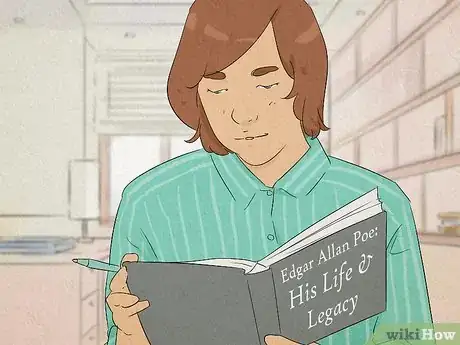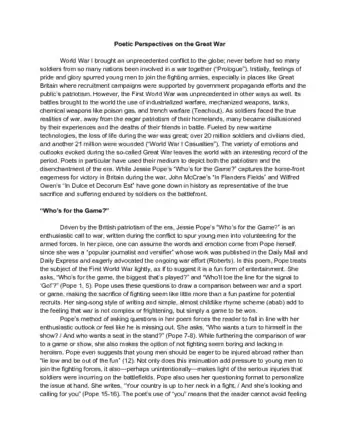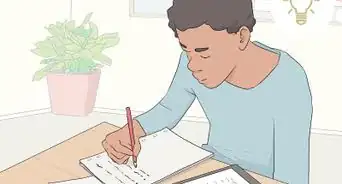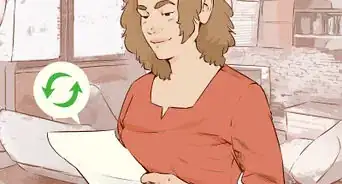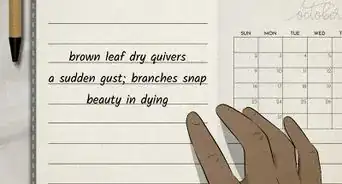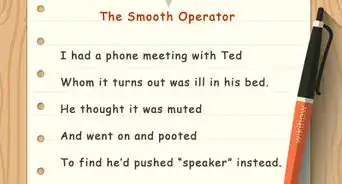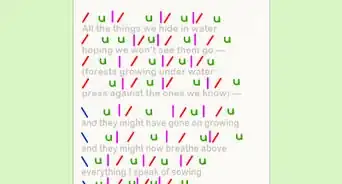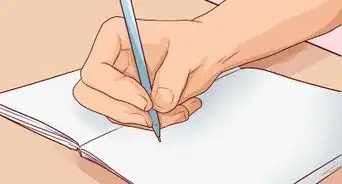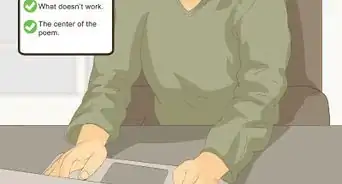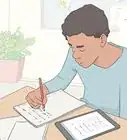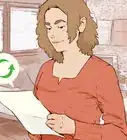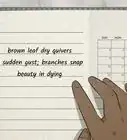This article was co-authored by Alicia Cook and by wikiHow staff writer, Amy Bobinger. Alicia Cook is a Professional Writer based in Newark, New Jersey. With over 12 years of experience, Alicia specializes in poetry and uses her platform to advocate for families affected by addiction and to fight for breaking the stigma against addiction and mental illness. She holds a BA in English and Journalism from Georgian Court University and an MBA from Saint Peter’s University. Alicia is a bestselling poet with Andrews McMeel Publishing and her work has been featured in numerous media outlets including the NY Post, CNN, USA Today, the HuffPost, the LA Times, American Songwriter Magazine, and Bustle. She was named by Teen Vogue as one of the 10 social media poets to know and her poetry mixtape, “Stuff I’ve Been Feeling Lately” was a finalist in the 2016 Goodreads Choice Awards.
There are 16 references cited in this article, which can be found at the bottom of the page.
wikiHow marks an article as reader-approved once it receives enough positive feedback. In this case, several readers have written to tell us that this article was helpful to them, earning it our reader-approved status.
This article has been viewed 632,779 times.
Do you feel like reading and analyzing poetry is like trying to decipher an ancient, lost art? Well, never fear! Whether you're working on an assignment for school or just critiquing it for fun, the process of analyzing poetry is easier than you think. Think about how the poem makes you feel, and look for clues in things like the poem's setting, characters, and imagery. Even the author's own life can give you clues into the poem's meaning!
Steps
Sample Analysis
Expert Q&A
Did you know you can get premium answers for this article?
Unlock premium answers by supporting wikiHow
-
QuestionWhat should you look for when you're analyzing a poem?
 Alicia CookAlicia Cook is a Professional Writer based in Newark, New Jersey. With over 12 years of experience, Alicia specializes in poetry and uses her platform to advocate for families affected by addiction and to fight for breaking the stigma against addiction and mental illness. She holds a BA in English and Journalism from Georgian Court University and an MBA from Saint Peter’s University. Alicia is a bestselling poet with Andrews McMeel Publishing and her work has been featured in numerous media outlets including the NY Post, CNN, USA Today, the HuffPost, the LA Times, American Songwriter Magazine, and Bustle. She was named by Teen Vogue as one of the 10 social media poets to know and her poetry mixtape, “Stuff I’ve Been Feeling Lately” was a finalist in the 2016 Goodreads Choice Awards.
Alicia CookAlicia Cook is a Professional Writer based in Newark, New Jersey. With over 12 years of experience, Alicia specializes in poetry and uses her platform to advocate for families affected by addiction and to fight for breaking the stigma against addiction and mental illness. She holds a BA in English and Journalism from Georgian Court University and an MBA from Saint Peter’s University. Alicia is a bestselling poet with Andrews McMeel Publishing and her work has been featured in numerous media outlets including the NY Post, CNN, USA Today, the HuffPost, the LA Times, American Songwriter Magazine, and Bustle. She was named by Teen Vogue as one of the 10 social media poets to know and her poetry mixtape, “Stuff I’ve Been Feeling Lately” was a finalist in the 2016 Goodreads Choice Awards.
Professional Writer
-
QuestionWhat are the 5 elements of poetry?
 wikiHow Staff EditorThis answer was written by one of our trained team of researchers who validated it for accuracy and comprehensiveness.
wikiHow Staff EditorThis answer was written by one of our trained team of researchers who validated it for accuracy and comprehensiveness.
Staff Answer wikiHow Staff EditorStaff Answer
wikiHow Staff EditorStaff Answer -
QuestionWhat are the rules for writing poetry?
 wikiHow Staff EditorThis answer was written by one of our trained team of researchers who validated it for accuracy and comprehensiveness.
wikiHow Staff EditorThis answer was written by one of our trained team of researchers who validated it for accuracy and comprehensiveness.
Staff Answer wikiHow Staff EditorStaff AnswerPoetry doesn’t really have specific rules, since it’s a very creative and personal form of expression. Typically, a poem focuses on creating a feeling by using strong imagery. However, some types of poetry follow a more formal structure—for example, specific rhyming schemes or rhythms. For instance, a haiku poem consists of 3 lines of 5, 7, and 5 syllables each.
wikiHow Staff EditorStaff AnswerPoetry doesn’t really have specific rules, since it’s a very creative and personal form of expression. Typically, a poem focuses on creating a feeling by using strong imagery. However, some types of poetry follow a more formal structure—for example, specific rhyming schemes or rhythms. For instance, a haiku poem consists of 3 lines of 5, 7, and 5 syllables each.
References
- ↑ https://www.teachforamerica.org/stories/how-to-analyze-a-poem-in-6-steps
- ↑ https://www.teachforamerica.org/stories/how-to-analyze-a-poem-in-6-steps
- ↑ https://writingcenter.tamu.edu/Students/Writing-Speaking-Guides/Alphabetical-List-of-Guides/Academic-Writing/Analysis/Analyzing-Poetry
- ↑ Alicia Cook. Professional Writer. Expert Interview. 11 December 2020.
- ↑ https://writingcenter.tamu.edu/Students/Writing-Speaking-Guides/Alphabetical-List-of-Guides/Academic-Writing/Analysis/Analyzing-Poetry
- ↑ http://www.vaniercollege.qc.ca/tlc/files/2016/08/Ten-Tips-for-Analyzing-Poetry.pdf
- ↑ https://www.litcharts.com/literary-devices-and-terms/ballad
- ↑ http://www.vaniercollege.qc.ca/tlc/files/2016/08/Ten-Tips-for-Analyzing-Poetry.pdf
- ↑ https://literarydevices.net/haiku/
- ↑ https://www.teachforamerica.org/stories/how-to-analyze-a-poem-in-6-steps
- ↑ https://writingcenter.tamu.edu/Students/Writing-Speaking-Guides/Alphabetical-List-of-Guides/Academic-Writing/Analysis/Analyzing-Poetry
- ↑ https://www.poetryfoundation.org/poems/47555/digging
- ↑ https://www.teachforamerica.org/stories/how-to-analyze-a-poem-in-6-steps
- ↑ http://www.vaniercollege.qc.ca/tlc/files/2016/08/Ten-Tips-for-Analyzing-Poetry.pdf
- ↑ https://writingcenter.tamu.edu/Students/Writing-Speaking-Guides/Alphabetical-List-of-Guides/Academic-Writing/Analysis/Analyzing-Poetry
- ↑ https://www.teachforamerica.org/stories/how-to-analyze-a-poem-in-6-steps
- ↑ https://writingcenter.tamu.edu/Students/Writing-Speaking-Guides/Alphabetical-List-of-Guides/Academic-Writing/Analysis/Analyzing-Poetry
- ↑ https://writingcenter.tamu.edu/Students/Writing-Speaking-Guides/Alphabetical-List-of-Guides/Academic-Writing/Analysis/Analyzing-Poetry
- ↑ Alicia Cook. Professional Writer. Expert Interview. 11 December 2020.
- ↑ https://www.poetryfoundation.org/poems/48999/daddy-56d22aafa45b2
- ↑ https://www.vaniercollege.qc.ca/tlc/files/2016/08/How-to-Analyze-a-Poem.pdf
- ↑ https://www.vaniercollege.qc.ca/tlc/files/2016/08/How-to-Analyze-a-Poem.pdf
- ↑ https://www.teachforamerica.org/stories/how-to-analyze-a-poem-in-6-steps
- ↑ https://www.vaniercollege.qc.ca/tlc/files/2016/08/How-to-Analyze-a-Poem.pdf
- ↑ https://writingcenter.tamu.edu/Students/Writing-Speaking-Guides/Alphabetical-List-of-Guides/Academic-Writing/Analysis/Analyzing-Poetry
About This Article
To analyze poetry, read the poem aloud several times and note if there’s a rhyming pattern. It's also important to identify if the poem uses a traditional form, like a sonnet or haiku. Next, think about how the title might announce key ideas or insights into the poem. Once you've studied the poem from a macro angle, take a closer look. Circle repeated words and images and question how they support the central ideas of the poem. For tips on how to use the poem’s historical context to better understand its meaning, keep reading!

